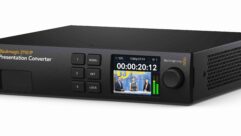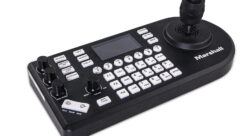

Controlled Decision: RS-232 vs.IP
Look at the back of any major-brand AV control processor these days and you’ll probably see a snapshot of an industry in transition.
Look at the back of any major-brand AV control processor these days and you’ll probably see a snapshot of an industry in transition. On one side of the device lies the gateway through which the industry appears headed: the TCP/IP network port. Nearby is the route control commands have largely taken to date: the RS-232 serial port.
Dan Walter of AV integrator ExhibitOne says he prefers the reliability of RS-232. “There’s one less thing to check.”
Credit: Wes Johnson / WPN
From projectors to audio DSPs to videoconferencing codecs–even film screens–pro AV manufacturers are increasingly building devices that can be controlled via an IP network where serial control has worked well in the past, thank you very much.
“When I first started at AMX almost eight years ago, every piece of equipment was either IR- or serial-controlled,” says AMX chief technology officer Robert Noble. “Now IP-based devices are 20 to 25 percent of what we’re seeing. And in three years, that will be up to 50 percent.”
With the proliferation of devices with Ethernet ports, many AV systems integrators have become early adopters, enamored by the advantages of network-based control–faster data transfer speeds, broader reach, etc. And many of them have become comfortable with the myriad complexities involved in network engineering.
“Once you’re on the network and you’re packetized, there are pretty much no limits to what you can control and where,” says Blaine Brown, director of technology for Indianapolis-based AV integrator Sensory Technologies.
“From my office, I can reach out and touch an IP-connected device in another building,” Noble adds. “You couldn’t do that with RS-232.”
Brown and his team are so comfortable with IP-based control systems that they’ll often build a dedicated network if a client doesn’t already have one to support the AV system they’re putting in. “We hope this trend toward TCP/IP control continues,” he says. “We can control as many devices as we want as long as the processor has an Ethernet port, and in a lot of cases we’re able to utilize network infrastructure that’s already in the building.”
Controlled Decision: RS-232 vs.IP
Look at the back of any major-brand AV control processor these days and you’ll probably see a snapshot of an industry in transition.
No Passing Fad
IP-based control is not a passing fad, but those serial ports on the other side of the control module are not likely to go away any time soon, either. A protocol for transferring serial binary data that was first defined in 1962 by the Electronic Industries Association as a standard for connecting electromagnetic typewriters to modems, RS-232 remains the most common way of controlling pro AV equipment in signal management systems.
“With RS-232, you have a dedicated pipeline, a two-way communication between two devices, and there’s nothing to interfere with it except the wire itself,” explains Rich Sasson, director of technical services for Crestron.
Blaine Brown of Sensory Technologies will build a dedicated IP network for his client’s AV systems to enhance control.
Credit: AJ Mast/WPN
There are still plenty of devices that can’t live on the network–DVD players and consumer audio equipment, for example. And call them Luddite, but plenty of AV pros out there still appreciate the reliable simplicity of controller and equipment communicating through just one serial cable.
“We predominantly use RS-232 in the systems we build,” says Dan Walter, senior programmer for Phoenix-based ExhibitOne Corp. “We just find it a lot more reliable. Anytime you put something like a network between two devices, you run the risk of something failing or not performing as it should. And with an RS-232-based system, there’s one less thing you have to check. I’ll put it this way: Everyone has used Ethernet at some point in their life, and everyone has lost Ethernet connectivity at some point, as well,” he explains.
“If you’re a more traditional AV dealer, you’re probably more comfortable with serial because you’ve been doing it so long,” Noble admits. “Everything is localized, and you’re in control. When you move onto a network, you have to realize that somewhere there’s an IT manager who owns it.”
So which control standard is right for your next project?
Pro AV breaks down some of the key advantages and disadvantages of both schemes.
Flexibility And Performance
(Advantage: IP)
Serial communication between two devices is defined by fairly stringent limits, with any increase in cable length mandating a direct and proportional decrease in the amount of data that can be transferred quickly. For that reason, RS-232 cable runs should extend no further than 50 feet as a general guideline, and AV equipment can never stray too far from its control module.
The number of devices controlled is also constrained, of course, by the number of RS-232 ports on the given control module, meaning that the addition of more system components can dramatically increase the cost of the controller.
These limits do not apply when the controller and the devices are on the network. Control spans to any addressable device and can extend as far as the network itself. This allows, for example, a technician on one side of a college campus to control a projector in an auditorium that’s half a mile away.
IP protocol enables greater expansion, too, with the number of equipment pieces that can be added to an AV system limited by network bandwidth but not by the number of ports on a processor.
Meanwhile, high bandwidth (the IT gods willing) enables faster communication between controller and device–gigabytes per second compared to RS-232’s maximum transfer rate of 19.2 megabytes per second–enabling device control to be far more granular than merely “on” and “off.”
And while RS-232 configurations require extensive wiring, existing IP infrastructure can now be found in most corporate, education, and government environments–even a lot of residential ones–enabling an AV integrator in many cases to leverage a network backbone that has already been established.
Controlled Decision: RS-232 vs.IP
Look at the back of any major-brand AV control processor these days and you’ll probably see a snapshot of an industry in transition.
Reliability & Ease of Use
(Advantage: RS-232)
While IP’s performance advantages may be clear on paper, foolproof network performance is something always strived for, yet rarely fully realized.
In the most basic sense, getting two electronic devices to talk to each other over a network merely requires setting a switch and a router. But client networks typically tie together a lot of equipment, and bandwidth often isn’t big enough to handle it all.
Indeed, from bandwidth and latency issues to the intricacies of IP address management, corporate IT environments are often full of unpredictability, and AV pros frequently face a terrain in which communication speeds fluctuate unacceptably and devices inexplicably get kicked off the network.
Whether it’s troubleshooting packet loss or trying to get through a firewall, for many AV operators, IT-world know-how is still a challenge, because they’re often called to solve communication problems occurring over networks that are usually unique in both configuration and complication.
And even the most IT-savvy AV professional often faces a fundamental issue of project control, because they’re beholden to an IT manager who has the final say on what can and cannot go on the company’s network.
RS-232 constitutes a far simpler communication scheme, with no intermediaries to mess up the process–a fixed pipeline with dedicated speed and timing, far easier to troubleshoot and tested over decades.
In fact, for basic, localized AV systems, putting control on the network can be silly, since turning a device on and off hardly requires data transfer speeds of up to 10 Gbps.
Troubleshooting RS-232 communication breakdowns is a fairly straightforward proposition for AV integrators who have been working with the standard for years and often know right off the bat whether a problem is related to faulty wiring or software issues (the only two possibilities to be concerned with when using this control protocol).
In contrast to the complex, fast-evolving knowledge base needed to service IP-based systems, serial communication involves a more base-level programming skill set, with simple ASCII code being sent and received between device and controller.
Meanwhile, having been around so long, RS-232 is a widely adopted standard in the broader electronics industry, meaning a wide swath of both consumer- and pro-level device brands can be controlled via the protocol without any compatibility issues.
Cost
(Advantage: RS-232)
This factor can be difficult to assess, given the absence of clear apples-to-apples comparisons. Looking at things pedantically, factors such as adding serial ports and the rather considerable labor time of soldering RJ45 connectors can drive up the cost of an RS-232 scheme. And running a lot of RS-232 cable can be an impractical solution when a sufficient network backbone is available and need only have devices be connected to it.
But the cost differential between serial and Ethernet control schemes is a bit more complicated than comparing additional connector ports to routers and hubs, and at this point in the evolution of IP-based control systems, the price advantage must narrowly go to RS-232.
Indeed, many AV systems integrators are still somewhere on the learning curve when it comes to troubleshooting networks. And often, the labor costs associated with falling down the rabbit hole of a complex bandwidth or incompatibility issue can far out-strip the additional price of buying a bigger control processor or running some additional serial cable.
The simple fact that IP-based standards are still much more in flux that those of the staid RS-232 realm means that, in aggregate, AV integrators are signing onto a more complex labor proposition when they choose to go with the new technology.
Of course, as this newer technology evolves, and AV integrators continue to gain experience with it, IP-based solutions will certainly become less fraught with client service calls.
Controlled Decision: RS-232 vs.IP
Look at the back of any major-brand AV control processor these days and you’ll probably see a snapshot of an industry in transition.
Conclusion
(Push)
More and more AV devices now come with the regular RS-232 serial control port as well as network port for IP-based control. Witness an AMX Netlink controller (top), Crestron Adagio Digital Media System (middle), and Barco DCS-100 switcher (bottom).
While positioning a staid-yet-established standard like RS-232 next to a far more dynamic yet more volatile one like IP makes for an interesting comparison, it’s likely that both schemes will continue to coexist within the AV business–and even be employed in conjunction–for years to come.
At this point in the evolution of both technologies, the decision to use one control technology over the other seems largely based on the integrator’s comfort level and usage scenario.
For example, should a control system be subject to the whims of the network when all it has to do is turn a projector and some lights on and off in a single room? Conversely, for a sprawling system employing such tools as advanced videoconferencing, an integrator would be foolish not to leverage an advanced communications network that’s already been built.
Over time, more and more devices, from disc players to coffee makers, will become network compatible, and IP standards will become more uniform. Eventually, like most technologies do, RS-232 will cede its ground and go away.
Still, even early adopters like Sensory Technologies’ Brown recognize that traditional AV houses are not close to giving up on RS-232. “It’s very comfortable for them because you’re not getting into the complexities that inherent with network-based control,” he explains. “Some of this stuff is still very intimidating.”
Daniel Frankel is a freelance technology writer based in Los Angeles and a frequent contributor to Pro AV.
Best of Both worlds
For installations where RS-232 and IP coexist, or where serial-based control is gradually being migrated to IP, there are technology solutions that straddle both worlds.
Avocent (www.avocent.com), for instance, makes a variety of serial hubs that allow integrators and AV end-users to access RS-232, RS-422, or RS-485-connected devices. The company’s ESP Serial Hubs come in 2-, 4-, 8-, and 16-port models (about $300 to $750 through various outlets). Internal Web servers allow you to manage the hubs and a Java-based ESP application can be used to remotely diagnose cable and device problems.
Magenta Research (www.magenta-research.com) sells very compact MultiView IP/Com interface modules (about 2.5 by 2.75 by 1.1 inches) for controlling and monitoring projectors, switchers, displays, and other serially controlled AV devices (RS-232 or RS-422).










